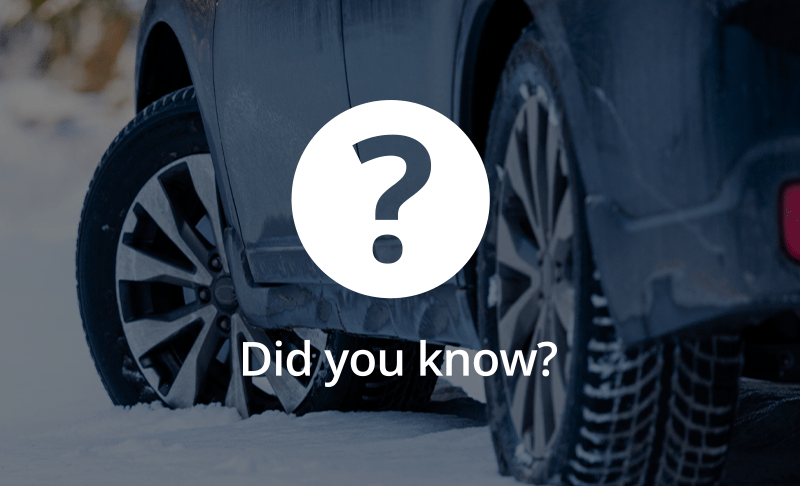
How Long Do Winter Tires Last?
If you drive on Canadian roads, you know how changeable the seasons can be when it comes to driving conditions. When buying your first car or your next car, one of your biggest questions might be: how long do winter tires last? It’s important to know the answer because driving on winter tires that are overdue for a replacement could make navigating the roadways more challenging. Here’s a look at how long you can expect your winter tires to last in Canada and what you can do when it’s time to replace them.
KEY TAKEAWAYS
- There are key differences between winter tires versus all-season tires.
- How long winter tires last depends on how often you drive and road conditions.
- Winter weather can affect your tires in various ways.
- You can maximize the life of your winter tires by doing a few things.
- There are solutions to make tire replacement easier and cheaper.
WINTER TIRES VS ALL-SEASON TIRES
It’s important to understand the differences between winter tires and all-season tires in order to make an informed decision. Below is a breakdown of the main differences:
Snow & Ice Handling
All-season tires can manage light snow, but their traction performance in heavy snow or icy conditions is not great. Winter tires have specialized tread patterns designed to provide maximum traction in these kinds of extreme conditions.
Tread Depths
Winter tires have deeper treads, which allow them to grip better and have greater traction in snow and slush. All-season tires have shallower tread depths, which don’t work as well in heavy snow.
Rubber Composition
Winter tires have a rubber composition that remains flexible in extreme cold. However, all-season tires can harden in severe cold temperatures, which reduces grip.
HOW LONG DO WINTER TIRES LAST?
So, how long do winter tires last? It really depends on how often you drive and what the road conditions are typically like. If you drive an average of 20,000 to 25,000 km per year like most Canadians, then you might get four to five winter seasons out of your tires. Some tires, however, may recommend that you drive fewer kilometres before replacing them. For example, your winter tires may only be rated to 60,000 km rather than 80,000 or 100,000. Others may be rated for more kilometres.
Winter tires can wear out faster the more you drive and the more difficult the road conditions. On the other hand, your winter tires may last longer if you prefer to drive in warmer weather and don’t drive that much in winter. You can also add unnecessary wear and tear and shorten your tires’ lifespan by driving on them all year round. In warmer weather, the hotter temperatures can cause the rubber your tires are made of to degrade more quickly.
Another rule of thumb to follow is to check the amount of wear on your winter tires. Once you reach the 50% to 75% wear point, it’s a good idea to reassess whether your tires can handle another winter. When you start to get this much wear on winter tires, braking and handling become less reliable. You may need to give yourself more time to stop and it may be more difficult to handle corners accurately when driving in rain, ice or snow.
How winter weather affects your tires
Winter tires are specially designed for driving in the typical conditions you’d expect in winter. In Canada, that means snow, ice, sleet and rain during the coldest parts of the year. Winter tires are meant to withstand temperature drops and handle different weather conditions so you can be reassured of your safety on the road.
Driving in winter conditions means your tires are subject to a different type of wear and tear than they might experience in the summer. Your tires have to be able to grip the road properly and handle well in ice, snow or rain. The newer a winter tire is, the better performance you’re likely to get when it comes to braking, handling and cornering.
As temperatures fluctuate, the cold can cause changes to your tire pressure. That in turn, can make the treads wear out faster or wear in irregular patterns. The same is true if you overinflate your tires in winter to compensate for pressure loss. Over-inflated winter tires can wear down in the middle of the tread pattern, which could prove dangerous when driving on icy roads. You may not have enough tread to grip the road if you begin to skid or slide on an icy patch. Not only that, driving on improperly inflated tires in winter can reduce your car’s fuel efficiency, causing you to burn more gas.
How long winter tires last
How long your winter tires last really depends on how often you drive and what the road conditions are typically like. If you drive an average of 20,000 to 25,000 kilometres per year like most Canadians, then you might get four to five winter seasons out of your tires. Some tires, however, may recommend that you drive fewer kilometres before replacing them. For example, your winter tires may only be rated to 60,000 kilometres rather than 80,000 or 100,000. Others may be rated for more kilometres.
Winter tires can wear out faster the more you drive and the more difficult the road conditions. On the other hand, your winter tires may last longer if you don’t drive that much in cold weather. You can also add unnecessary wear and tear and shorten your tires’ lifespan by driving on them all year round. In summer, the warmer temperatures can cause the rubber your tires are made of to degrade more quickly.
Another rule of thumb to follow is to assess the amount of wear on your winter tires. Once you reach the 50% to 75% wear point, it’s a good idea to reassess whether your tires can handle another winter. When you start to get this much wear on winter tires, braking and handling becomes less reliable. You may need to give yourself more time to stop and it may be more difficult to handle corners accurately when driving in rain, ice or snow.
MAXIMIZING THE LIFE OF YOUR WINTER TIRES
Inspect Your Current Winter Tires
There are several ways to evaluate whether your winter tires are in need of a replacement. As you prepare for winter, here are a few rules of thumb to keep in mind:
- Check the treads. Do a visual inspection of your winter tire treads to look for any obvious clues that they’re worn out. Check for unusual wear patterns and look to see if your tires have a built-in number indicator. This indicator can tell you if the tread is getting too low.
- Do the toonie test. Pull out a toonie and slip it into your tire treads. If your tire tread reaches the bear’s paws, then they should still have plenty of life left in them. On the other hand, if you can read the word “DOLLARS” printed on the bottom of the coin then your tires are likely due for an upgrade.
- Use a depth gauge. A depth gauge is another way to check your winter tires’ lifespan. Most winter tires have 0.79 cm to 0.95 cm (10/32″ to 12/32″) of tread depth to start. If you test your depth gauge and it reads below 0.55 cm (7/32″), that’s a sign that you should probably consider replacing your winter tires.
Drive Slowly & Maintain Good Separation
In extreme cold temperatures, tires can wear out faster. This is due to ice and snow causing tires to slide and rotate more often than they would in summer weather, creating more wear and tear on the rubber. Make sure you slow down in winter driving conditions to allow your tires to grip better. Also, reduce the distance required to stop to lessen any unnecessary additional friction.
Maintain Proper Tire Pressure
Cold weather causes tire pressure to drop, which is why it’s important to check the tire pressure frequently. When your tires are properly inflated, you’ll have the best handling on snow and ice. Taking a bit of time to check and maintain tire pressure in the winter will help your tires perform their best in the winter.
If You Need To Replace One Tire, Replace All Your Tires
If you end up in a situation where only one of your tires needs replacing, it’s important to replace all four of them at the same time. Only switching out one tire can put you in danger because your car will have a harder time handling winter road conditions. Also, the treads on your other three tires will end up wearing unevenly if you change out just one.
Store Your Winter Tires Properly
Storing your tires properly can significantly extend the life of your tires. Here’s how to do it:
- Store indoors. Did you know? Tires age more quickly when they are exposed to heat or light. This is because they’re black, which means they absorb sunlight and can easily heat up to 49°C. This is why you need to store your winter tires indoors and keep them away from hot temperatures.
- Clean before storing. It’s important to clean your tires before storing them because they pick up dust, dirt and grime while driving that can cause damage. Just wipe them down with some soap and water and let them dry completely before storing them away.
- Look for signs of rot. If you’re pulling your winter tires out of storage, also give them a thorough once-over to look for signs of dry rot. Specifically, look for cracking patterns on the tire treads or sidewall and discolouration. Also, feel the tires to see if they still have a rubbery quality. If tires feel brittle or dried out, that could suggest that dry rot has set in and you need some new winter tires.
Tips for winter tire replacement
Replacing winter tires can be expensive but there are solutions that can make it easier. The MPI Winter Tire Program, offered by Manitoba Public Insurance, can help you get access to low-cost financing to make your winter tire purchase. The program covers the tire replacement itself, along with rims, valve stems and storage if you prepay for those items at the time you purchase your winter tires. You just need to be a Manitoba Public Insurance customer and purchase your tires from a participating seller to be eligible for the program.
Also, think carefully about replacing just some of your winter tires. Ideally, you should replace all four to ensure even wear and tear as you drive in winter. If you can only swap out two of your winter tires, put the new ones in the rear of your vehicle and the older ones at the front.
DRIVE SAFELY THIS WINTER
At Birchwood Credit Solutions, we want every driver to feel safe on the road. That’s why we offer an extensive inventory of high quality vehicles to suit almost any driving need. Browse our online inventory today to see our selection of cars, trucks, SUVs and minivans. If you need financing to make your next used car purchase, we work with buyers from almost every credit background. Whether you’re new to Canada and still building credit or rebuilding credit after a bankruptcy or divorce, Birchwood Credit Solutions can help. Get the loan process started by completing our online application today.



